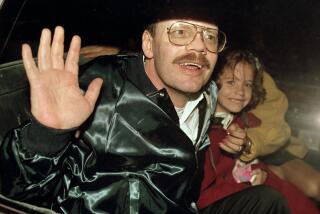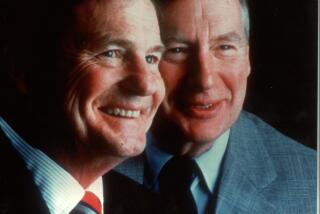Pioneering TV journalist Marlene Sanders dies at 84
In 1964, broadcast journalist Marlene Sanders became the first woman to anchor an evening network newscast.
It was a breakthrough, but more or less accidental. At a time when opportunities were scarce for women in network news, Sanders got the chance to anchor the ABC broadcast because the regular anchor got sick and lost his voice.
“She had to fight a lot of stereotypes and a lot of ridicule,” said Bill Moyers, who worked with Sanders on a documentary series at CBS. “But she hung in there and did really good work. She caused the first tinkling of the glass ceiling.”
Sanders, who also broke through stereotypes when she covered the Vietnam War and became the first female vice president of news at a network, died Tuesday in a hospice facility in New York City.
The cause was cancer, said her son Jeffrey Toobin, who followed her into journalism — he is a legal analyst for CNN and writes for the New Yorker.
Sanders, who won three Emmys for her work on TV documentaries, did in-depth reporting on topics such as the emerging women’s movement, the right to die and overpopulation. And in addition to the war, she covered the assassination of Robert Kennedy, the volatile 1968 Democratic National Convention in Chicago and other national events.
But she was also pigeonholed in many ways, especially early in her career. At the time she got the chance at anchoring, she had an afternoon show called “News With the Woman’s Touch.”
“Food, fashion, child-rearing, decorating, social events and the entertainment scene were all you could expect” as a woman in the field, she said in her 1988 book, “Waiting for Prime Time: the Women of Television News,” written with Marcia Rock.
“Of course, 1964 was the Dark Ages as far as women’s progress was concerned,” Sanders said, quoted in the 1987 book, “Hard News: Women in Broadcast Journalism.”
“Not only were women not an issue; no one was even thinking about them at all.”
Gradually, Sanders was able to get more hard-news assignments as a reporter. In 1965, she covered the inauguration of President Lyndon Johnson, and a year later she was sent to Vietnam to do reports that appeared on her afternoon show and the nightly news.
As the women’s movement became more prominent, Sanders saw her chance to make a difference on how the topic was presented. “In the initial phase of the women’s movement, reporting on it was done mainly by men, and it was snide and hostile,” she wrote in “Waiting for Prime Time.”
“Women’s lib was treated with humor at best and contempt at worst.”
In 1970 at ABC, she was the correspondent on “Women’s Liberation,” the first of seven documentaries on women’s issues she worked on at the network.
Sanders was born Jan 31, 1931, in Cleveland. She excelled at school and extracurricular activities, sometimes too much in the view of her mother.
“’Now dear, remember boys don’t like girls who are too smart,’” Sander said in a 1973 Seventeen magazine interview, recalling her mother’s advice. “That made me so angry, I couldn’t stand it! I knew that the traditional role was not going to be enough for me.”
After graduating from high school in 1948, she attended Ohio State University, but left to study acting in a variety of venues. It didn’t work out as a career choice — years later, she said the title of the Off-Broadway play in which she had a role mercifully escaped her. But while working at a summer theater in Rhode Island, she met broadcaster Mike Wallace, who was producing a stage show there.
He got her a job in 1955 as a production assistant on his local newscast in New York on WABD-TV (later WNEW-TV). She followed him to his breakthrough interview show, “Night Beat,” and after he moved on, she produced other interview shows, including one hosted by Monte Hall, later of “Let’s Make a Deal” fame.
She joined ABC in 1964 and eventually rose to the position of vice president in charge of documentaries. But when network sports producer Roone Arledge was additionally put in charge of ABC News in 1977, Sanders moved on, telling the New York Times that her “interest may not be the same as those of the new management.”
Landing at CBS News, Sanders covered numerous stories in depth, including segments for “60 Minutes.” She won two Emmys as writer and correspondent on the documentary “What Shall We Do About Mother?” about elder care, and another for writing “Nurse, Where Are You?” about a critical nurse shortage.
Moyers, who worked with her at the network, remembers her as a professional who didn’t show anger, but she was no pushover. “She was resolved, she was a fighter,” he said in an interview Wednesday. “A lot of women owe their own freedom in journalism to the Marlene Sanders of the world.”
But she became increasingly concerned that TV network news was losing its edge. “The kiss of death was when someone discovered that news could be profitable,” she said in a 1986 speech to the Oregon Assn. of Broadcasters. “What has been happening is an increase in entertainment values in the news.”
Sanders left CBS in 1987 in the midst of a downsizing, declining an offer to switch full-time to the network’s radio news. She moved on to do work in public television and taught journalism at several venues.
She felt her legacy was in her coverage of the women’s movement.
“As I look back on my career, the women’s movement provided an exceptional point when time, place and position all came together to give me the power and focus to contribute to the country’s awareness of the status of women,” she wrote in “Waiting for Prime Time.”
“For once, I seemed to be in the right place at the right time.”
Her husband, Jerome Toobin, died in 1984. She is survived by her son and three grandchildren.
david.colker@latimes.com
More to Read
Start your day right
Sign up for Essential California for the L.A. Times biggest news, features and recommendations in your inbox six days a week.
You may occasionally receive promotional content from the Los Angeles Times.







